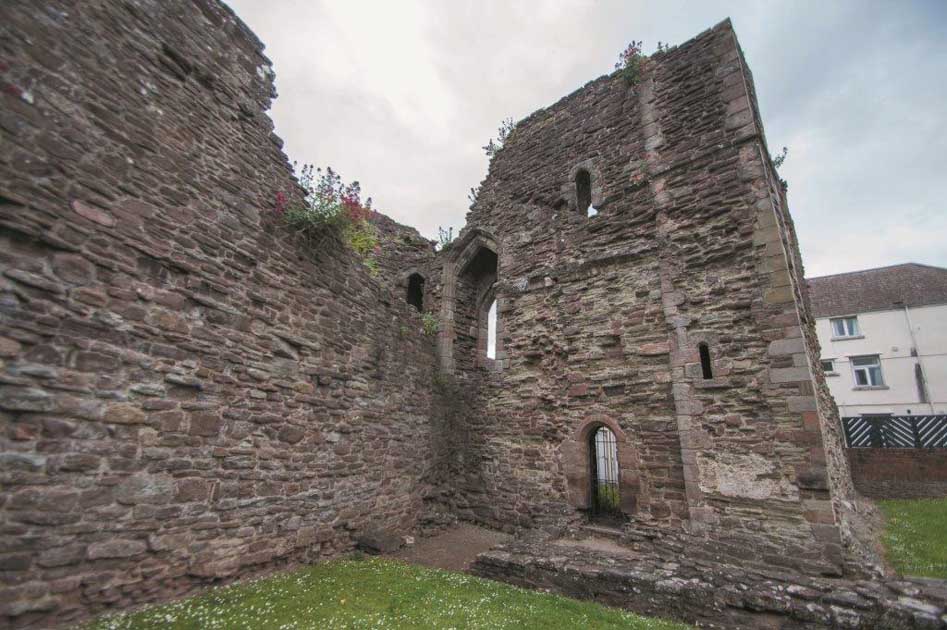Monmouth Castle

Monmouth Castle Details
Monmouth Castle, ruins of royal C11-C17 castle largely destroyed C17 + built over
- Closest To: Monmouth
- Access: Free Public Access
- Grid Reference: SO507129
Monmouth Castle occupies a large rocky outcrop overlooking the River Monnow upstream of its confluence with the River Wye. The mound is an irregular shape, with a pronounced curve on the north-west corner, and measures a substantial 80 metres by 100 metres, roughly speaking. Monmouth was the site of two Roman forts and an English burh, and it seems likely that, as was the case in places like Exeter, Wallingford and Wareham, the castle was constructed in the corner of an existing defended settlement of some size. Indeed, it may have been the site of an English royal settlement, as Monmouth was held by King Edward the Confessor in 1066 according to the Domesday Book, valued at a not insignificant £35. Monmouth was at the very least strengthened by William fitzOsborn in the 1060s and 1070s, and this was fortified in stone by the 1150s at the latest, the Great Tower being a close match to that at Chepstow. FitzOsbern seems to have had an arrangement with the local Welsh king, Caradoc ap Gruffudd allowing the three early castles at Chepstow, Caerleon and Monmouth to be constructed. By 1086 Monmouth was held by the Breton lord William fitzBaderon, and his descendants followed as lords of Monmouth; Baderon fitzWilliam in 1125, Gilbert fitzBaderon in 1176, and John fitzGilbert, known as John of Monmouth, in 1190. His son John of Monmouth (II), who succeeded him in 1248, fell into debt, and in 1257 Monmouth was surrendered to the Crown, and was assigned to Prince Edward, the future Edward I. It may be that the construction of a great round keep, dated to approximately 1230, contributed to the financial problems.
During the 1260s, Simon de Montfort briefly took over the control of Monmouth Castle, but it was recovered by the Crown in 1265 and two years later assigned to Prince Edmund, the younger son of King Henry III, when he was created Earl of Lancaster. Edmund commissioned the Great Hall as an extension to the old 12th century tower-keep, and this building remained in use as a court into the 17th century. In the mid 14th century tall windows were inserted into the first floor great hall of this building at the instruction of Henry of Grosmont, who probably made considerable additions and modernisations to the place. When Grosmont died in 1360/61, Monmouth was inherited by his younger daughter, who had married John of Gaunt, the third surviving son of King Edward III, the previous year. Gaunt then became Earl of Lancaster, and almost certainly added more to the castle, and it was here that his grandson, the future Henry V, was born. The castle then fell into a life of quiet respectability, despite the Glyndwr Revolt and the Wars of the Roses, until the mid 17th century. During the Civil War, the castle was held for King Charles, and changed hands more than once. On 1st March 1647 Parliament issued an instruction that the castle be slighted, and this involved the demolition of the round tower-keep as well as much of the walling and gatehouse. In 1673 the ruined tower was taken down and the masonry reused by Henry Somerset, later Duke of Beaufort, to build himself a new house to replace the damaged Raglan Castle. The great hall remained in use as the county court until 1724. In the 19th century this house was made the headquarters of the Royal Monmouthshire Royal Engineers, and was much extended as a result. Today it houses a museum, and it is possible to see parts of the Great Hall and 12th century tower-keep from the grounds.
Become a supporter of my work to access a more detailed history